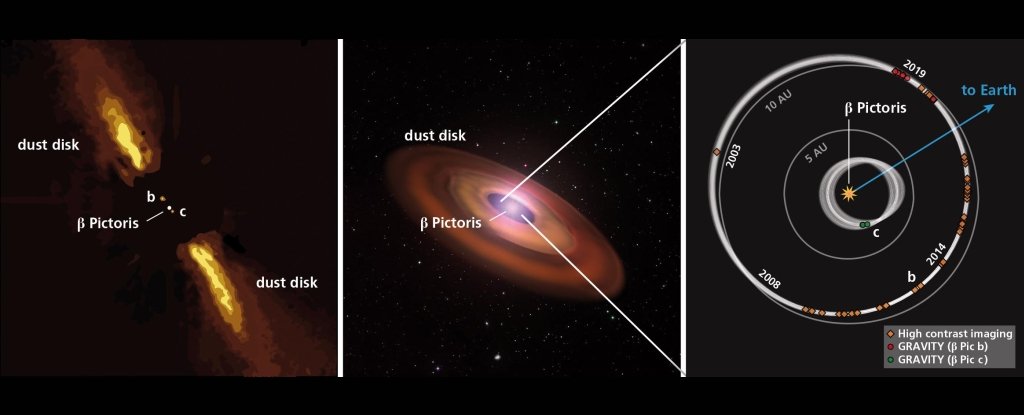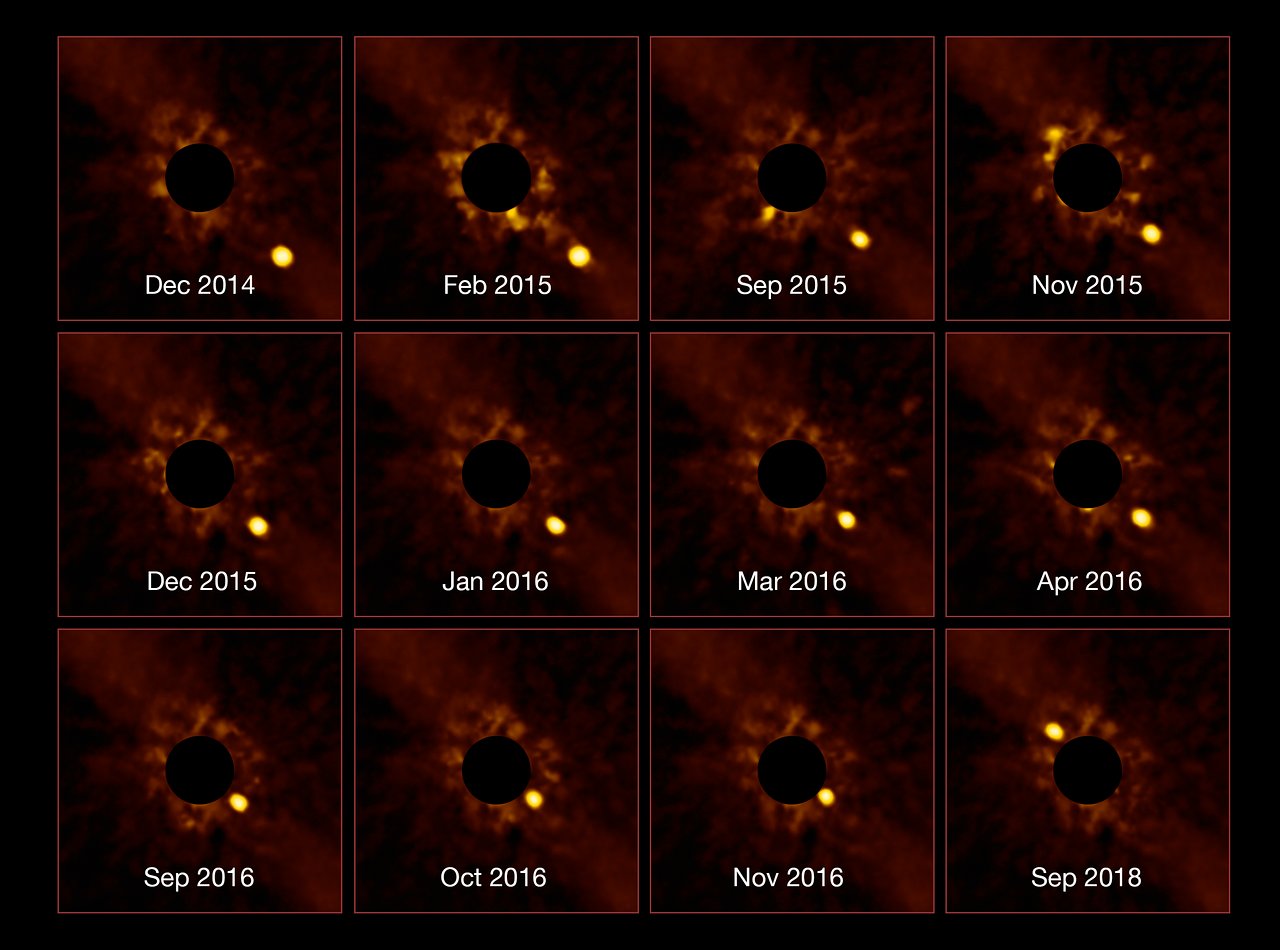
Posted on 10/02/2020 12:05:02 PM PDT by Red Badger

Illustrations of Beta Pictoris system (l.; c.); the system's dimensions (r.). (GRAVITY Collaboration/Axel M. Quetz, MPIA Graphics Department)
================================================================================
Most of the exoplanets we've confirmed to date have never actually been seen directly. We confirm their presence by indirect means, such as the effect they have on their host star. But now, astronomers have revealed images of an indirectly found exoplanet.
It's not just an impressive feat of skills and technology. The combination of methods has given us a superb toolkit for measuring an exoplanet. For the first time, astronomers have measured both the brightness and the mass of an exoplanet - which has given us a new probe into how planets form.
The exoplanet is Beta Pictoris c (β Pic c), a gas giant orbiting the star - you guessed it - Beta Pictoris, just 63 light-years away. It's a very young, very bright star, around 23 million years old; as such, it's still surrounded by a lot of dusty debris, and its exoplanets - we've confirmed two to date - are just babies, around 18.5 million years old.
β Pic c is the second of those planets, and it was discovered using the radial velocity method. Stars, you see, don't sit stationary while planets whirl around them; the two bodies exert a gravitational tug on each other, and the orbit is around a mutual centre of gravity.
So, if you look at a star and you can see it wobbling a little in place - its light lengthening into redder wavelengths, or redshifting, as it moves away, and shortening into bluer wavelengths, or blueshifting, as it moves closer, that often means its being tugged by an exoplanet. The bigger the exoplanet, the bigger the gravitational tug it exerts on the star.
Beta Pictoris b (β Pic b), a gas giant up to 13 times the mass of Jupiter, was discovered in 2008 via direct imaging. So, it was expected that the star would wobble.
But, while studying observational data taken over the preceding 16 years, a wobble noticed by astronomer Anne-Marie Lagrange of Grenoble Observatory in France and colleagues was inconsistent with β Pic b. Instead, it seemed to be a second, previously undetected exoplanet.
They unveiled their newly discovered exoplanet - β Pic c - last year.
Enter the ExoGRAVITY collaboration, a project using the GRAVITY instrument on the Very Large Telescope Interferometer to directly image exoplanets. The ExoGRAVITY team thought β Pic c would make an excellent candidate for direct imaging.
They had been looking for an exoplanet with a good set of radial velocity data, and since β Pic c's sibling had already been directly imaged, it seemed a good bet.
Very few exoplanets can be directly imaged with our current technology. They need to be sufficiently distant from their star; otherwise they disappear into the glare. Our most reliable exoplanet detection methods work best on very close stars. And it's helpful if the exoplanet is quite young, since such planets are still warm enough to emit thermal radiation.
As it turned out, β Pic c was perfect. Those years of wobble data provided an excellent profile of the exoplanet's movement; the ExoGRAVITY team, led by astronomer Mathias Nowak of the University of Cambridge in the UK, was able to home in on the location and obtain direct images. That work has now led to an exoplanet dataset the likes of which we've never had before.
The radial velocity data were used to calculate the exoplanet's mass and orbit; it clocks in at around 8.2 times the mass of Jupiter, and orbits the star at 2.7 astronomical units, with an orbital period of 3.4 years. So far, so normal.
But the direct images revealed a surprise - β Pic c is surprisingly faint, six times fainter than its sibling, even though the two exoplanets are of similar size, suggesting that it's much cooler. β Pic c's brightness suggests its temperature is around 1,250 Kelvin, compared to 1,724 Kelvin for β Pic b.
This could be a clue as to how the exoplanet formed: In models, the temperature of a baby exoplanet is related to its formation method.
In the disc instability formation model, part of the protoplanetary disc of dust and gas swirling around the newborn star collapses directly into a gas giant. In this model, the exoplanet has no solid core, and forms hotter and brighter.
In the core accretion model, pieces of rock in the protoplanetary disc stick together, first via electrostatic forces, then via gravity, forming a larger and larger body, building a planet from the bottom up. The resulting exoplanet has a solid core, and forms cooler and dimmer.
Because β Pic c is smaller and dimmer than expected, and because the disc instability model requires the exoplanet to form much farther from its host star than β Pic c is today, the team believes that the exoplanet formed via core accretion.
It's a fascinating result, but there is still work to be done. We don't have a reliable mass estimate for β Pic b - it could be anywhere between 9 and 13 times the mass of Jupiter. It's orbiting the star at a greater distance than β Pic c, which means we don't have enough wobble data to infer its mass. How it formed will be harder to gauge until we can narrow this down.
And there's more work to be done on β Pic c. The next step will be to take detailed spectra of the light being emitted by the exoplanet. From this, scientists can work out the planet's atmospheric composition - a key technique in looking for signs of life elsewhere in the galaxy.
The research has been published in two papers in Astronomy & Astrophysics, here and here.
ya
I thought it was Mulva Prime.
I had an Exoplanet once. :(
Traded it for a Maple 73’ Rickenbacker 4001.

Yeah, my immediate thought, too. 63 light years away is an eternity to us slow-pokes... =:-)
https://reverb.com/item/27549630-rickenbacker-4001-1973-mapleglo
$2500 - $4000 now.
I wanted to be Chris Squire.
But if you traveled there at the speed of light, you wouldn’t be any older when you arrived.
It literally takes less than an hour to get there at 70 LY/h which is the current interstellar speed limit.
Totally doable.
Well then, I’ve got my boarding pass. Do I have to remove my shoes?
Lots of interesting stuff happening in astronomy these days.

No, but you have to wear a mask all the way there...unless you are actively eating or drinking.
think about it; at 186,000 miles per second, times the number of seconds in a year. wow
60 X 60 X 24 X 365 X 186,000= 5.8 trillion miles
And below is the planet orbiting it's parent star.

Disclaimer: Opinions posted on Free Republic are those of the individual posters and do not necessarily represent the opinion of Free Republic or its management. All materials posted herein are protected by copyright law and the exemption for fair use of copyrighted works.